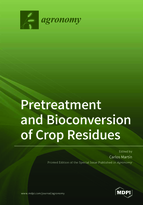Pretreatment and Bioconversion of Crop Residues
A special issue of Agronomy (ISSN 2073-4395). This special issue belongs to the section "Agricultural Biosystem and Biological Engineering".
Deadline for manuscript submissions: closed (31 January 2021) | Viewed by 59328
Special Issue Editor
2. Department of Chemistry, Umeå University, 901 87 Umeå, Sweden
Interests: lignocellulosic materials; pretreatment; enzymatic hydrolysis of cellulose; biorefineries; biochemical conversion of lignocellulose; cellulosic ethanol; biofuels
Special Issues, Collections and Topics in MDPI journals
Special Issue Information
Dear Colleagues,
The expected depletion of fossil resources is a major challenge requiring the promotion of alternative feedstocks to enhance energy and material security. Crop residues are widespread lignocellulosic materials with high potential as feedstocks for producing biofuels and chemicals via sugar–platform processes, in which polysaccharides are hydrolyzed to sugars for further conversion through microbial, enzymatic or chemical processing. Enzymatic saccharification of cellulose is a selective approach for deconstructing biomass, but it is hindered by the inherent recalcitrance of lignocellulosic feedstocks. By implementing pretreatment, the barriers causing recalcitrance are removed or weakened in such a way that the feedstock turns amenable for enzymatic saccharification. Lignocellulose pretreatment is still an open topic, since most of the existing methods are far from being mature for implementation in commercial-scale biorefineries. Furthermore, pretreatment effectiveness is feedstock-dependent, and new research is required to develop efficient methods for different materials. This Special Issue is devoted to summarizing the latest advances in pretreatment and bioconversion of crop residues. Contributions concerning novel pretreatment and bioconversion approaches and methods applicable to agricultural, agro-industrial, and food industry residues are especially welcome.
Dr. Carlos Martín
Guest Editor
Manuscript Submission Information
Manuscripts should be submitted online at www.mdpi.com by registering and logging in to this website. Once you are registered, click here to go to the submission form. Manuscripts can be submitted until the deadline. All submissions that pass pre-check are peer-reviewed. Accepted papers will be published continuously in the journal (as soon as accepted) and will be listed together on the special issue website. Research articles, review articles as well as short communications are invited. For planned papers, a title and short abstract (about 100 words) can be sent to the Editorial Office for announcement on this website.
Submitted manuscripts should not have been published previously, nor be under consideration for publication elsewhere (except conference proceedings papers). All manuscripts are thoroughly refereed through a single-blind peer-review process. A guide for authors and other relevant information for submission of manuscripts is available on the Instructions for Authors page. Agronomy is an international peer-reviewed open access monthly journal published by MDPI.
Please visit the Instructions for Authors page before submitting a manuscript. The Article Processing Charge (APC) for publication in this open access journal is 2600 CHF (Swiss Francs). Submitted papers should be well formatted and use good English. Authors may use MDPI's English editing service prior to publication or during author revisions.
Keywords
- pretreatment
- bioconversion
- enzymatic hydrolysis
- lignocellulosic materials
- crop residues






